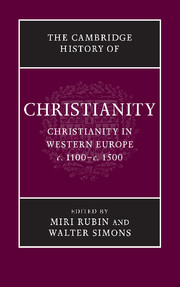Book contents
- Frontmatter
- Introduction
- PART I INSTITUTIONS AND CHANGE: 1100–1200
- PART II FORGING A CHRISTIAN WORLD, 1200–1300
- PART III THE ERECTION OF BOUNDARIES
- PART IV SHAPES OF A CHRISTIAN WORLD
- PART V CHRISTIAN LIFE IN MOVEMENT
- PART VI THE CHALLENGES TO A CHRISTIAN SOCIETY
- 23 Repression and power
- 24 Faith and the intellectuals I
- 25 Faith and the intellectuals II
- PART VII REFORM AND RENEWAL
- Select bibliography
- Index
- Map 1 Western Europe c. 1100 – c. 1500
- Map 2 Universities of Europe
- References
25 - Faith and the intellectuals II
from PART VI - THE CHALLENGES TO A CHRISTIAN SOCIETY
Published online by Cambridge University Press: 28 March 2010
- Frontmatter
- Introduction
- PART I INSTITUTIONS AND CHANGE: 1100–1200
- PART II FORGING A CHRISTIAN WORLD, 1200–1300
- PART III THE ERECTION OF BOUNDARIES
- PART IV SHAPES OF A CHRISTIAN WORLD
- PART V CHRISTIAN LIFE IN MOVEMENT
- PART VI THE CHALLENGES TO A CHRISTIAN SOCIETY
- 23 Repression and power
- 24 Faith and the intellectuals I
- 25 Faith and the intellectuals II
- PART VII REFORM AND RENEWAL
- Select bibliography
- Index
- Map 1 Western Europe c. 1100 – c. 1500
- Map 2 Universities of Europe
- References
Summary
This article concerns the persistent preoccupation with the boundaries between inquiry and faith, as they appear in the context of the liberal arts (artes liberals) in the high and in the later Middle Ages. Since Late Antiquity the liberal arts represented the basic learning in Christian schools, where they served as a prerequisite for biblical studies. Before one considers their role on the borderline of religious and secular inquiry, a short outline of their development in the Christian world is necessary.
Christian authors such as St Augustine and St Jerome adopted the concept of the liberal arts from Greek and Roman models. In the first century CE Philon of Alexandria had defined the arts a ‘circle’ or ‘chorus’ of preliminary sophistic studies, which included grammar, rhetoric, geometry, music, but also arithmetic, dialectic and astronomy. These subjects had the inferior rank of ‘intermediate learning’. For Philon the circle of studies was represented by Abraham’s maid Hagar, who gave birth to Ishmael, but who was repudiated by Abraham together with her son (Gen. 16 and 21). On the other hand, Abraham’s spouse Sarah, the mother of the legitimate son Isaac, was interpreted as the figure of philosophy, virtue and wisdom.
Keywords
- Type
- Chapter
- Information
- The Cambridge History of Christianity , pp. 394 - 404Publisher: Cambridge University PressPrint publication year: 2009



